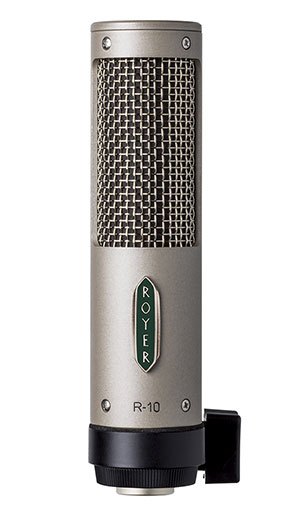Royer Labs announce New R-10 passive ribbon microphone

Burbank based microphone company, Royer Labs, one of the foremost manufacturers of
ribbon microphones have announced a brand new passive ribbon microphone – the R-10,
which uses the same element found in the acclaimed R-121 active ribbon mic and is
designed for studio and live use.
According to the product description the mic that is hand-built in Royer’s Burbank
California factory, can handles SPLs of up to 160 dB @ 1 kHz. The R-10’s compact
size and mounting system allows for flexible, unobtrusive positioning.
Other main features of the microphone reportedly include:
- The R-10’s 2.5-micron aluminum ribbon element is formed with Royer’s patented
direct-corrugation process and is protected by a 3-layer windscreen system and
internally shock-mounted ribbon transducer. The ribbon transducer is wired for
humbucking to reject electromagnetically induced noise.
- The R-10’s built-in windscreen provides superior protection from air blasts
and plosives. It also reduces proximity effect (bass buildup from close miking)
so guitar cabinets and acoustic instruments can be close-miked with less bass
buildup. The R-10’s internally shockmounted ribbon transducer isolates the ribbon
element from shocks and vibrations, increasing the ribbon element’s durability.
- The R-10 utilizes a David Royer custom designed transformer for high overload
threshold, minimizing saturation at even extremely high sound pressure levels.
You’ll never overload an R-10! The mic’s open grill design minimizes standing waves
and associated comb-filtering effects and its smooth frequency response, phase
linearity and lack of self-distortion make it ideal for all digital recording and
live sound formats.
- The R-10 shows some of its best stuff on studio and live electrics, capturing
all the low end, midrange warmth and punch guitarists and engineers have come to
expect from a Royer. If you want more bite in the highs but don’t want to
multi-mic (particularly on live stages where blending microphones can create
phase-related problems), the R-10 takes EQ beautifully and we suggest
experimenting with your favorite EQ unit or plugin.
- The R-10 is excellent on brass and can handle close-miked trumpets,
trombones and other brass instruments. Brass records naturally on an R-10, as
bright as the musician plays but without the added sizzle or harshness commonly
experienced when condenser mics are used on brass instruments.
- Drums are full bodied with realistic (not over-hyped) transients response,
and the R-10’s figure-8 pattern conveys superb ambience and depth when used for
room miking applications. A compressed R-10 in front of the kit sounds huge and
punchy.
- R-10 recordings of violins, ukuleles, steel-stringed and nylon-stringed
acoustic guitars, banjos and other stringed instruments are warmth and natural
and fit into mixes easily. “Airing out” the recorded track by opening up a bit
of 12K with an EQ often gives surprisingly good results.